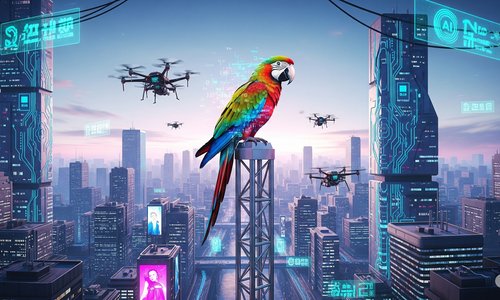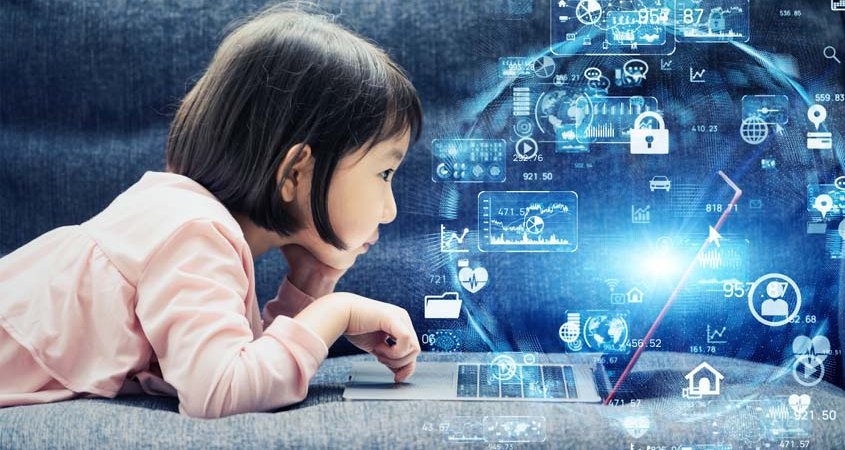
A Promessa e o Perigo da Nova Revolução Digital
A nova corrida tecnológica global levanta uma pergunta urgente: estamos prontos para confiar na inteligência que criamos?

CRIANÇAS E ADOLESCENTES NA ERA DIGITAL
Figura 1 - imagem criada DALL-E. Prompt: crianças e adolescentes sentados na natureza interagindo com tecnologia e IA
No Dia das Crianças, importante abordar a atual transformação digital por que passa a sociedade humana, acelerada pela emergente era da inteligência artificial, exigindo um esforço coletivo para mitigar os riscos e impactos para a infância e juventude.
Paira no imaginário coletivo, a associação entre os avanços tecnológicos e as gerações mais novas, em razão da intimidade que essas gerações pós Millenials demonstram com as diversas engenhocas eletrônicas e as redes sociais. Afinal, já nasceram imersas nesse meio tecnológico e o tempo anterior, antes do smartphone, simplesmente não faz parte de suas memórias.
Esse pensamento nem de longe é verdadeiro, e leva ao chamado etarismo digital, alijando, por puro preconceito, outras gerações e distanciando o real foco do debate: Como proporcionar a inclusão digital, com segurança, potencializando seus benefícios e mitigando riscos, para todas as faixas geracionais, em especial para as faixas mais vulneráveis?
O recorte desse post recai para a infância e juventude, pelo qual abordaremos alguns impactos nessa era digital.
Segundo a pesquisa TIK KIDS ONLINE BRASIL, promovida pelo comitê gestor da internet (gov.br) e conduzida pelo Centro Regional de Estudos para o Desenvolvimento da Sociedade da Informação (Cetic.br) do Núcleo de Informação e Coordenação do Ponto BR (NIC.br), com resultado divulgado em 16 de agosto de 2022, constatou que 93% das crianças e adolescentes do Brasil são usuárias da internet, identificando o celular como equipamento majoritário para o acesso. (Nove em cada dez crianças e adolescentes são usuárias de internet | Agência Brasil (ebc.com.br))
Todo esse avanço tecnológico, agora impulsionado pela emergência da Inteligência Artificial, permite vários usos e benefícios, como também impactos e riscos que precisam ser avaliados por pais e responsáveis e a rede de proteção da infância e juventude.
Como benefícios, podem ser elencados:
*Educação – internet móvel potencializada com a expansão do 5g e o uso de inteligência artificial possibilitam novos recursos educacionais, em ambientes imersivos para estudos, como história, astronomia, geologia, geográfica, experimentos químicos e muitas outras possibilidades, com acesso a uma vasta quantidade de informações. Plataformas de ensino à distância e aplicativos educativos também se tornam possíveis, sendo que estes últimos, conectados com algoritmos de IA poderão em alguns anos se tornarem tutores de crianças e adolescentes auxiliando o processo pedagógico.
* Socialização e Comunicação - Facilidade de comunicação com amigos e familiares, em especial quando moram em outras cidades, evitando assim perder o vínculo de contato com crianças e adolescentes. A participação em comunidades online e grupos de interesse voltados à faixa etária específica pode ser um mecanismo de inserção e descoberta de sociabilidade em especial para aqueles que apresentam algum grau de neurodiversidade.
* Desenvolvimento de Habilidades - Aprendizado de novas habilidades, como programação e design. Estímulo à criatividade através de plataformas de criação de conteúdo.
* Adoção de sistemas de segurança por pais e responsáveis para o resguardo da integridade física, com rápida localização em caso de perda ou mesmo sequestro.
Os riscos também estão presentes:
*Exposição a Conteúdos Inapropriados - Acesso a conteúdos violentos, pornográficos ou prejudiciais.
*Cyberbullying - Riscos de assédio e bullying no ambiente online. Além de interação com adultos em redes sociais se passando por crianças e adolescentes.
*Saúde Mental e Física - Problemas relacionados ao tempo de tela levando a esgotamento saúde mental, insônia e sedentarismo, além de ansiedade e depressão. A sociedade brasileira de pediatria tem alertado para os riscos do tempo de tela excessivos de crianças (https://www.sbp.com.br/imprensa/detalhe/nid/sbp-atualiza-recomendacoes-sobre-saude-de-criancas-e-adolescentes-na-era-digital/)
*Privacidade e Segurança - Riscos de compartilhamento de informações pessoais. Vulnerabilidade a golpes e fraudes on-line. Nesse tópico a ANPD (Autoridade Nacional de Proteção de Dados) publicou enunciado no dia 22 de maio de 2023:
"O tratamento de dados pessoais de crianças e adolescentes poderá ser realizado com base nas hipóteses legais previstas no art. 7º ou no art. 11 da Lei Geral de Proteção de Dados Pessoais (LGPD), desde que observado e prevalecente o seu melhor interesse, a ser avaliado no caso concreto, nos termos do art. 14 da Lei.”
Surge, assim, a necessidade de medidas preventivas para o uso correto dos meios digitais por crianças e adolescentes:
O mundo digital carrega os seus riscos e do mesmo modo que o mundo físico, os responsáveis pelas crianças e adolescentes devem se cercar de cuidados para possibilitar um ambiente seguro de navegação e uso de tecnologias.
O grande desafio, ante a aceleração atual, é que tantos as famílias, quanto educadores e rede de proteção não estão devidamente preparados para efetivar as medidas de segurança e orientação do segmento infanto-juvenil, o que traz problemas para toda a sociedade e desproteção para esse vulnerável segmento.
Diferentemente do que acontece em países Europeus como a França (Les enfants ont-ils le droit d’acheter sur Internet | Orange Bank), o Brasil ainda não tem uma regulamentação específica para:
Neste último tópico, importante destacar os riscos atuais da IA generativa. O vídeo da operadora Alemã Deutsche Telekom (https://youtu.be/FrdhsX8R_AY?si=oQKLFcoHEzwPx6N7) que usa a técnica de deepfake para mostrar como as fotos e vídeos de crianças na internet podem ser usados para criar imagens falsas e prejudiciais no futuro, utilizando o banco de dados oriundos da exposição excessiva em redes sociais, alertou pais e responsáveis sobre os riscos de exposição de imagens de crianças e adolescentes nos meios digitais.
A mesma IA generativa que pode auxiliar os processos educacionais ou a identificar os netos desaparecidos durante a ditadura militar na Argentina, pelo grupo “Avós da praça de Maio” (https://www.uol.com.br/tilt/noticias/afp/2023/07/22/designer-argentino-usa-ia-para-procurar-bebes-desaparecidos-durante-a-ditadura.htm) , pode também colocar em risco a segurança de crianças ao possibilitar a construção de avatares e linguagem, possibilitando que por por trás daquele perfil ou avatar estejam adultos em ação de pedofilia.
A transformação da educação também se afigura como um enorme desafio e assume papel preponderante nessa era digital. Os processos educacionais devem estar atentos para preparar a “futura geração dos futuros empregos”, que ao que tudo indica, exigirá uma crescente especialização, além de habilidade de soft skills para essa geração que está crescendo no meio digital e vivenciando impactos sociais, emocionais e mentais não experenciados pelas gerações anteriores, o que exige de todos a atenção necessária para a proteção, por questões inclusive de soberania futura do país.
Figura 2. Imagem criada DALL-E. Prompt: crianças e adolescentes interagindo num ambiente futurista
Os desafios atuais exigem que a família, a rede de proteção da infância e juventude e toda a sociedade estejam atentos para efetivar a proteção, coibindo abusos e prejuízos para crianças e adolescentes, mas otimizando o uso das tecnologias, preparando os cidadãos para uma sociedade inclusiva e responsável digitalmente, e assim, resguardando o futuro da sociedade brasileira.
Flávia Valéria
Mestranda em Blockchain e Criptocurrencies pela University of Nicosia (Unic) pelo departamento Institute for the future.
Pós-graduanda em Neurociência, psicologia positiva e mindfulness pela PUC-PR.
Associada I2AI.
Promotora de Justiça no Estado do Maranhão.
Coordenadora do Projeto de pesquisa da ESMP-MPMA MP Trends.
Professora na Escola Superior do Ministério Público do Maranhão. Coordenadora do grupo de estudos e pesquisa "MP Trends" ("highlights" tecnológicas e seus impactos para a atuação do setor público especialmente para o sistema de justiça) da escola superior (ESMP/MPMA). Promotora de Justiça/MA. Atualmente mestranda em “Blockchain e Criptoativos” (University Nicosia) e pos graduanda em Neurociência, psicologia positiva e mindfulness pela PUC/PR.

A nova corrida tecnológica global levanta uma pergunta urgente: estamos prontos para confiar na inteligência que criamos?

Por que dominar a IA será a nova alfabetização do século XXI

Conselhos de Administração devem evoluir da supervisão reativa para a antecipação estratégica, frente à crescente complexidade e volatilidade dos ambientes de negócios.

De 14 a 25 de julho, reserve suas manhãs das 08h00 às 09h30 para participar da tradicional Maratona I2AI! Uma jornada intensa com debates e palestras sobre temas essenciais: Ética,